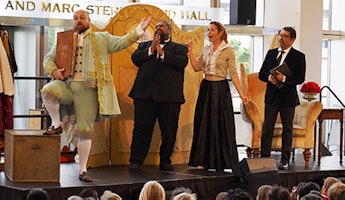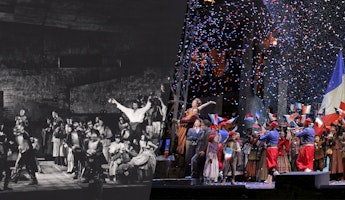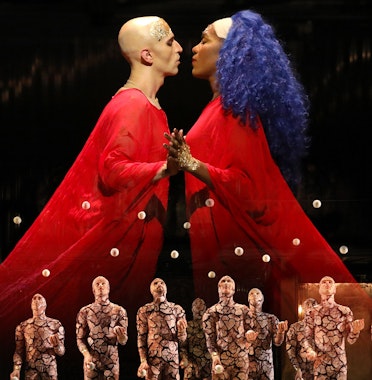Blog
September 4, 2025
Minds Behind the Masterpiece: Jerome Robbins
At a time when dance companies in the USA loved to showcase American dreams and values, choreographer Jerome Robbins burst into the scene with the desire to show one thing: the American reality. Robbins believed that dance was as powerful as music, theater, writing, any art form, to deliver a story that would move people and ask them hard questions about the state of the world they’re living in. However, a career in dance wasn’t his original plan. He entered NYU to study chemistry but when his family’s financial situation began to deteriorate, he had to leave that dream behind. So, at the age of 26, after falling back in love with ballet thanks to accompanying his sister to dance lessons, Robbins used his talent as a dancer to start making money as a chorister on Broadway.
Robbins was living out most dancer’s dreams as a member of Ballet Theatre (renamed American Ballet Theatre in 1957). But Robbins wasn’t satisfied with being in the background and dancing the standard repertoire. He even joked that “I never seemed to get out of boots, Russian bloomers, and a peasant wig.” After being with that company for four years, he decided it was time to stop dancing the classics and create a new ballet that captured the energy of the 1940s. The result was Fancy Free.
To compose the music for the ballet, Robbins enlisted the help of a fellow unknown, Leonard Bernstein. Together, they crafted a ballet that captured a youthful spirit that was unseen in ballet with a topical dive into the immature attitude of WWII sailors that are attempting (and failing) to woo women during their 24-hours leave. Fancy Free is now considered a ballet classic and was the stepping stone that Robbins and Bernstein needed to launch their careers to the insane heights they would soon reach. Not only was this quite the achievement for their first go-around, but even more impressive with the frantic and haphazard way the ballet was put together. Bernstein mailed homemade records of his score to Robbins who was on tour and then scheduled rehearsals in between performances to account for everyone’s busy schedule. If this type of production was given to less talented hands, then Fancy Free would've gone down as an incomprehensible flop.
Around the time of Fancy Free’s opening on April 18, 1944, Robbins joined other left-wing radicals and became a member of the Communist Party. His association with the party would only last until 1947, but the impact of that decision would haunt Robbins and lead him to say that he had made “a great mistake in joining the Communist Party.”
But at the time, what worries could he have had? Robbins took his runaway success with Fancy Free and worked with Bernstein to transform it into a Broadway hit, On the Town. It was during On the Town that Robbins’ fortitude in his beliefs became apparent when he refused to put on a musical set in New York that did not reflect the racial diversity of the city in its class. What resulted was one of the most diverse casts seen on Broadway at the time, helping usher in a more inclusive era.
Robbins’ life would become more complicated as he explored his identity in 1947, the same year that he won his first Tony Award for Mack Sennett’s High Button Shoes, when he joined the original class of New York City’s Actors Studio. Among his classmates were a plethora of theater and film legends such as Marlon Brando, Sidney Lumet, Maureen Stapleton, Herbert Berghof, and most importantly for Robbins, Montgomery Clift. When Clift and Robbins first met, there was an instant spark and though Robbins’ great love at the time was ballerina Tanaquil LeClerc, he was starting to realize that he didn't’ just have romantic feelings towards women.
The affair between Clift and Robbins would last until around 1948 when Clift signed a Hollywood contract and moved across the country to star in The Search. But before their breakup, it is reported that Clift approached Robbins with an idea for a musical, it would be a modern re-telling of Romeo and Juliet but follow New York gangs instead. This idea would eventually turn into West Side Story (which you can learn more about by clicking here.)
Robbins’ newfound sexuality was a great revelation for him; however, it would be turned against him at the start of the 1950s when the government decided to start cracking down on communism. Robbins’ had cut ties with the communist party, but his past association made him a prime target. The House of Un-American Activities Committee would pester Robbins for three years to release names, but it wasn’t until they threatened to leak his homosexual activities (punishable by jail time in that era), that he finally agreed to name ten names. Robbins’ decision was the most controversial one he made, causing many of his colleagues to openly disdain him. Robbins' mulled over whether he made the right decision, but it was West Side Story collaborator Arthur Laurents that made it clear to Robbins when he called the choreographer a “sh**.”
Robbins career thrived in the 1950s, when he was choreographing for hit shows like West Side Story, The King and I and Gypsy, but it was a turbulent time for his personal life. The aforementioned turmoil was paired with Robbins’ struggle with his Jewish identity and then a personal tragedy. In 1956, his muse Tanaquil LeClercq became paralyzed after contracting polio, resulting in Robbins withdrawing from his work at New York City Ballet. However, one does not just drop what they love, and Robbins instead founded his own small dance company, Ballets USA, which saw great success for its scale and allowed Robbins to have creative freedom. It was how he was able to keep his career momentum going in the 1950s despite the hard times.
By 1964, Robbins would start to gain acceptance as a Jew when he would direct and choreograph Fiddler on the Roof. Robbins felt a great affinity for the story as, much like the characters in the musical, his own parents were immigrants from eastern Europe who immigrated due to Russia’s treatment of Jewish people. Fiddler was the last musical Robbins would get off the ground, and it can be argued to be his magnum opus, with the bottle dance being one of the most iconic sequences in all of Broadway.
After Fiddler, Robbins would bow out of Broadway for years—although he eventually returned in 1989 to stage the anthology show Jerome Robbins’ Broadway—but his early influence can still be felt to this day. Many choreographers cite Robbins as an idol including another legendary choreographer/director, Bob Fosse. After Broadway, Robbins continued to work in ballet, choreographing for the Joffrey Ballet and New York City Ballet, solidifying his influence in the ballet world as well as Broadway.
By 1996, Robbins’ was showing signs of a form of Parkinson’s disease, and his hearing was quickly deteriorating too. He had the strength to complete only one more project, a staging of Les Noces in 1998. Only two months after the premiere, Jerome Robbins would pass away in his home on July 29, 1998. On the night of his death, all the Broadway theaters paid respect to him by dimming their marquee lights for a moment in honor of the man who helped changed the directory of musical theater and ballet.
Robbins was a passionate perfectionist who lived for dancing and championed the art form’s ability to evoke emotions and stories. By all accounts, he was a hard man to work with, but those who did knew they were working with a legend and said that it was working with Robbins truly started their careers. At his heart, Robbins was a man who wanted to see more diversity on stage, wanted to see great change in the world and truly believed that his art could help usher that change in. Now, over 100 years after his birth, we're still trying to see the great change that Robbins wanted. But maybe through art we can find it somewhere.
To see West Side Story, click here.








/03-cosi/_dsc0996_pr.jpg?format=auto&fit=crop&w=345&h=200&auto=format)














